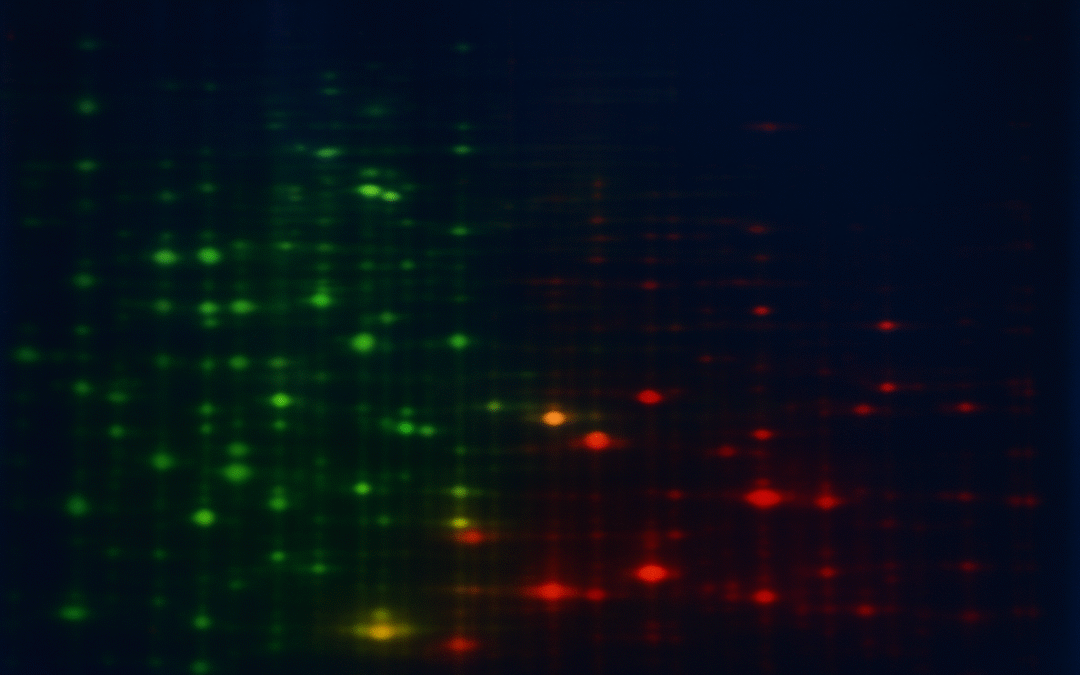When researchers need to understand subtle changes in protein expression between samples — whether it’s healthy vs. diseased tissue, treated vs. untreated cells, or developmental stages — one of the most trusted approaches is Two-Dimensional Difference Gel Electrophoresis (2D-DIGE).
Unlike traditional gel-based proteomics, 2D-DIGE uses fluorescent dye labeling to allow multiple protein samples to be separated and compared on the same gel. This eliminates gel-to-gel variation, increases accuracy, and makes it possible to detect even small differences in protein abundance.
At ITSI-Biosciences, we provide high-quality 2D-DIGE services that give researchers the clarity and precision needed for meaningful discoveries in comparative proteomics.
Why 2D-DIGE?
Traditional 2D-PAGE methods, while powerful, suffer from reproducibility issues when comparing separate gels. 2D-DIGE solves this by labeling different protein samples with distinct fluorescent CyDyes (commonly Cy3, Cy5, and Cy2). These samples are then run together on the same gel.
The result?
-
Accurate, reproducible comparisons of protein expression.
-
Minimized experimental variation caused by differences between gels.
-
Simultaneous analysis of multiple samples in a single run.
This makes 2D-DIGE especially valuable for experiments where detecting subtle but biologically significant changes in protein abundance is critical.
Applications of 2D-DIGE in Research
ITSI-Biosciences’ 2D-DIGE services are widely applicable across biomedical and life science research. Common applications include:
-
Biomarker Discovery: Identifying proteins that differ between disease and control samples.
-
Drug Development: Monitoring protein expression changes in response to treatments.
-
Toxicology Studies: Evaluating how environmental factors or chemicals alter protein expression.
-
Systems Biology: Mapping protein expression patterns to better understand cellular pathways.
Our 2D-DIGE Workflow
At ITSI-Biosciences, we combine technical expertise with careful attention to quality, ensuring reliable data for every project. Our 2D-DIGE workflow includes:
- Protein Extraction & Quantification – Ensuring high-quality protein samples for downstream analysis.
- Fluorescent Labeling with CyDyes – Assigning different dyes to different samples (e.g., control vs. treatment).
- 2D Gel Electrophoresis – Separating proteins by isoelectric point and molecular weight.
- Gel Imaging & Analysis – Using high-resolution scanners to capture fluorescent signals.
- Comparative Protein Expression Profiling – Identifying proteins that are up- or down-regulated across conditions.
- Optional Protein Spot Identification – Excising and analyzing spots via mass spectrometry for protein identification.
This end-to-end workflow allows our clients to move from sample to biological insights with confidence.
Why Partner with ITSI-Biosciences?
-
Expertise You Can Trust: With years of experience in proteomics, we ensure the highest level of technical precision.
-
Customizable Services: We tailor our 2D-DIGE analysis to fit your experimental design and research questions.
-
Quality and Reproducibility: We adhere to strict quality controls, ensuring your data is reliable and publication-ready.
-
Integrated Solutions: For projects that go beyond protein separation, ITSI-Biosciences can combine 2D-DIGE with downstream protein identification and bioinformatics.
Conclusion
Whether you are searching for biomarkers, evaluating drug responses, or exploring fundamental biological processes, 2D-DIGE remains one of the most reliable methods for comparative proteomics. With ITSI-Biosciences as your partner, you gain access to not only cutting-edge technology but also the expertise needed to translate your samples into meaningful discoveries.
📩 Contact us today via email (itsi@itsibio.com) or phone (814-262-7331) to learn how our 2D-DIGE services can support your research.


